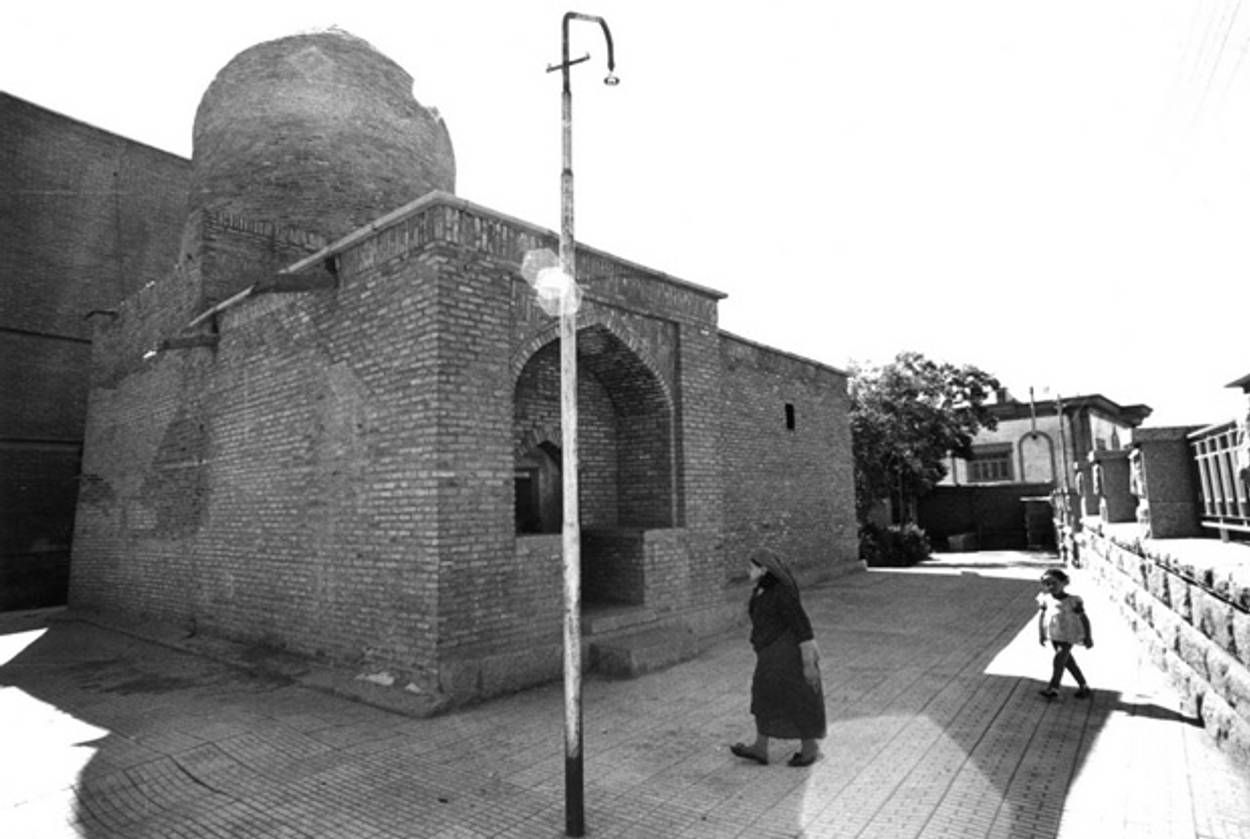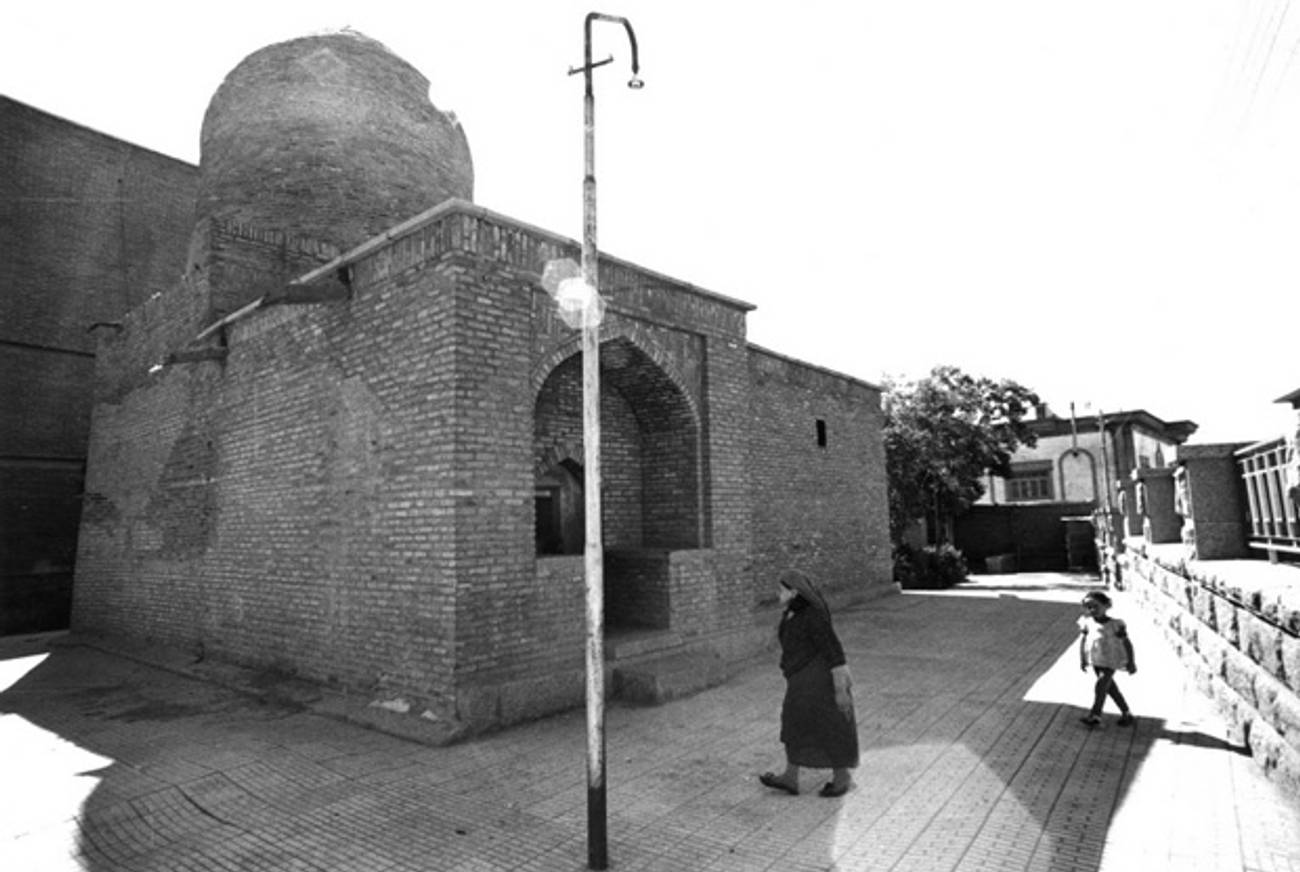Renderings
Unable to restore a shrine with a prominent Star of David in Iran, a U.S. organization and an Iranian-American architect are reviving the site online




There is quite possibly only one Star of David on Earth visible from space. Coordinates: 34.797924 N, 48.512927 E. Location: Hamadan, Iran.
Until just over a year ago, the Islamic Republic had hosted a second star: Israeli engineers commissioned by the shah in the 1970s to construct Iran Air headquarters in Tehran put an unmistakable Magen David on the roof of the airport building. But the discovery of the symbol by a Google Earth user in November 2010 scandalized the mullahs. An Iranian news site reproached Tehran’s municipal authorities for failing to remove “this Zionist star symbol, 32 years after the success of the revolution.”
More recent Google Earth images show that the airport star is now covered by black concrete. But the other Star of David—the one remaining in the western Iranian city of Hamadan—attests to millennia of shared Persian-Jewish history.
The problem is that the shrine that houses the prominent star has fallen into disrepair at the hands of the local government, and last year anti-Jewish mobs rallied at the shrine, calling for its demolition. In the absence of a Jewish community capable of defending it, a U.S. organization called Diarna (Judeo-Arabic for “Our Homes”) has decided the only option is to restore the site—virtually.
***
For centuries, Persian Jews marked the holiday of Purim by traveling to the shrine in Hamadan. There they were often joined by Christian and Muslim supplicants seeking divine cures to infertility and other human ailments. According to Persian-Jewish lore, the biblical queen Esther and her uncle Mordechai—celebrated in the Book of Esther for having prevented a mass slaughter of their fellow Jews during the time of the Achaemenid emperor Xerxes I—are buried at the shrine. But construction of the site most likely post-dated by a few centuries the events depicted in the Book of Esther. A different Persian-Jewish queen—Shushan Dokht, wife to the 4th-century Sassanid emperor Yazdegerd I—may actually be buried there.
While the shrine’s origins remain shrouded in mystery, its centrality to Persian-Jewish life is well-documented. “This place is regarded by all the Jews of Persia as peculiarly sacred,” wrote a visiting American journalist in the July 1872 issue of Our Monthly, a long-defunct literary and religious magazine. “Hither they come up on pilgrimage with something of the spirit in which their fathers sought the gates of Jerusalem.”
Venerated though it was, the shrine of Esther and Mordechai was, by the late 1800s, in a state of decay. The Our Monthly writer described “a square room with projections on its sides, the whole between thirty and forty feet in height, or nearly square, and surmounted by a cylindrical tower and dome, near forty feet in height.” From the outside, the shrine was nothing more than “a square brick mausoleum, built for strength rather than beauty. The open midan, or ground above the tomb, is equally uninviting. It is used by the Mussulmans as a wood and timber market and … piled with newly cut trees, branches and fuel. There is not a spear of grass, or leaf or flower near the tomb, but much that is offensive and filthy.”
The site remained in this state until 1972, when Elias “Yassi” Gabbay, then a rising Jewish-Iranian architect, was commissioned to restore it. That year, the shah’s regime launched an extravagant celebration of 2,500 years of Persian monarchy, and every minority group in the country was required to participate. The Jews, the country’s oldest minority community, settled that restoring the Hamadan shrine was the best way to capture their contribution to Persian history.
Gabbay did more than just restore the original shrine. He added a subterranean synagogue while retaining much of the original shrine structure and surrounding cemetery, where Hamadan’s most prominent Jewish families buried their dead. “My main goal in approaching the architectural concept was to express the relationship of the Jews of Iran … with the Iranian nation,” he recalled in a 2010 interview with Diarna, which digitally restores Mizrahi heritage sites across the Middle East and North Africa.
The only above-ground portion of the new synagogue’s structure was the roof, which includes a massive skylight in the shape of a Star of David that can be spotted in Google Earth images of Hamadan.
The Islamic revolution of 1979 forced Gabbay and an estimated 60,000 other Persian Jews to leave Iran for Israel and the United States. Like many, Gabbay resettled in Beverly Hills, where he maintains an architectural practice. Since then, the site he restored has been maltreated by Islamist authorities in Hamadan, who have removed the fence designed by Gabbay lest passersby be offended by its ornate Star of David motif. (Never mind that the motif was inspired in part by ancient Islamic design patterns where six-pointed stars are quite common.)
Given the shrine’s precarious condition, Diarna considered it a perfect candidate for digital restoration. An initiative of a Boston-based nonprofit named Digital Heritage Mapping, Diarna combines traditional archaeological and historical scholarship with digital technologies to revive neglected Jewish sites in a region where autocrats and Islamists have sought to eradicate any physical evidence of Jewish life. (Historic sites are virtually revived with online exhibits that include photographs, 3-D images, immersive panoramas, and so on.)
In the case of the Hamadan shrine, Diarna had the benefit of missionary and journalistic accounts from the late 19th and early 20th centuries, as well as Gabbay’s black-and-white photographs. Sadly, Gabbay’s original plans for the 1972 restoration were lost after the 1979 revolution, so the architect had to reconstruct them from memory. “Just as people often question the origins of the Esther shrine, so I have to question the accuracy of my memory,” he said in 2010.
The memories of Persian Jews born in Iran are increasingly all that remain of their heritage. The Hamadan shrine is not the only site at risk of destruction. In April 2008, for example, seven ancient synagogues in Tehran’s historically Jewish Oudlajan district were razed to make way for high-rise developments.
Growing up in post-revolutionary Iran as the only son of a secular-minded Shia family, I was fortunate to know Jewish friends of my parents, including a prominent gallery owner and artist who for many years shared a studio with my mother, an abstract-expressionist painter. But the Jewish experience as a whole was something muted and private—not a surprise in a country where anti-Semitic propaganda pervades state-controlled media and where Jews and other minorities are required to hang signs on their stores to warn away unsuspecting Muslims from shopping there. As a child, I found it impossible to even imagine the time when Tehran was home to thriving, bustling centers of Jewish life.
Ideally, governments in Iran and the Arab-speaking Middle East would be rushing to preserve priceless Jewish sites within their borders rather than leaving it up to a team of programmers to restore them in Google’s soulless, if infinite, memory. Viewing Diarna’s end-product—with its three-dimensional computer graphics devoid of imperfections—I could not help but recall French theorist Jean Baudrillard’s warning against postmodern simulacra. In their very perfection and completeness, maps, models, and databases can sometimes overwhelm memory and subjectivity, which are defined by absences, scars, and negative spaces impossible to recreate digitally.
Sohrab Ahmari is the assistant books editor at The Wall Street Journal and co-editor of Arab Spring Dreams, an anthology of essays by young Mideast reformers.
Sohrab Ahmari is the assistant books editor at The Wall Street Journal and co-editor of Arab Spring Dreams, an anthology of essays by young Mideast reformers.